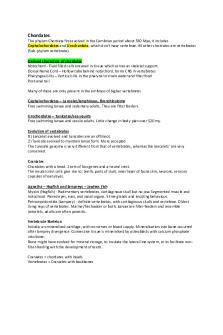DES142A Lecture 12 PDF

| Title | DES142A Lecture 12 |
|---|---|
| Author | Karin Dabach |
| Course | History of Eastern Textiles |
| Institution | University of California Davis |
| Pages | 2 |
| File Size | 45.7 KB |
| File Type | |
| Total Downloads | 88 |
| Total Views | 125 |
Summary
lecture notes...
Description
●
●
China Guizhou Province ○ Subtropical, home of 18 minority groups ○ Helped preserve a lot of traditions (textile and agricultural techniques), cultural revolution passed (didn’t infiltrate into this remote region) ○ The Miao and the Dong are the most popular groups ■ Common creation men Miao ○ Made up of a bunch of sub-groups ○ Have a lot of different costume traditions ■ Silver crowns and metal disks on head ○ Hair is usual ■ They add extra hair, sometimes it possibly could be the ancestors hair ■ They add yarn, wrap around a piece of wood that the hair is wrapped around ○ Complex embroidery shows patience, shows that you can do hard work, shows artistic sense ■ Values in community ■ Helps finding a good husband ○ If a girl is interested in a boy, she’ll put a ribbon around his neck and if he’s interested too, he’ll bring it back to her at the end of the night. ■ Some of these traditions are being lost because young people are going to school/college ○ Indigo dyed hemp fabric & commercially produced cotton, a little bit a silk ○ Calendaring ■ Creates the sheen on the fabric ■ Antiseptic that helps skin diseases but creates sheen yellow fabric ○ Decorations cover up calendar ○ Grandmother passes knowledge to daughter whose expected to pass it down to her daughters ○ Each group has its own identifiable embellishments ■ Miao Couched Braid Embroidery - instead of sewing through fabric, they apply these braids and add stitches through braids to attach to fabric ■ 8-14 strands of silk and braid on basket (bobbins - holding a different color of silk) ● Girls start learning when they’re 7-8 ■ Flat braids is usually for shoulders, dimensional braids are used to create patterns ○ Motifs of insects, butterflies, flowers ■ Some are made of felted silk (butterfly) ○ Colors are meant to be auspicious (lucky) -- provides good luck ○ Made from tin/heavy silver paper (aluminum foil) to detract spirits ○ Festive attire included hats decorated with silver pieces on it ■ All silver was made by men and women did the embroidery
■ ■ ●
●
They put all of their money into the silver because there are no banks Pieces are passed down by generation to generation
Dong ○ Sun and ancestor worship, animism (keep the gods placated) ■ Believe in different spirits and many gods, usually have shaman ■ Images like snakes, moon, dragon as symbols of protection ■ You can identify dong because of their needle work (cultural identity and social status) ○ They wear indigo dyed cotton, embroider it, neck pieces ○ Known for the architecture ■ Homes are built of fur, elaborate homes ■ Families live in upper two stories, animals and storage on ground level ■ Live near rivers and streams ■ Wind/rain bridges -- covered walkway that connects two sides of the river ● Benches inside for gatherings Buyi girls making laran (wax resist) ○...
Similar Free PDFs

DES142A Lecture 12
- 2 Pages

12 - Lecture notes 12
- 3 Pages

Lecture notes, lecture 12
- 9 Pages

Lecture notes, lecture 12
- 7 Pages

Lecture 12
- 7 Pages

Lecture 12
- 3 Pages

Chapter 12 - Lecture notes 12
- 4 Pages

Lab 12 - Lecture notes 12
- 5 Pages

LEC 12 - Lecture notes 12
- 3 Pages

(12) Mistake - Lecture notes 12
- 8 Pages

Chapter 12 - Lecture notes 12
- 9 Pages

Lecture notes, lecture 1-12
- 64 Pages

Sachvui - Lecture notes 12
- 271 Pages

Mujadid - Lecture notes 12
- 1 Pages
Popular Institutions
- Tinajero National High School - Annex
- Politeknik Caltex Riau
- Yokohama City University
- SGT University
- University of Al-Qadisiyah
- Divine Word College of Vigan
- Techniek College Rotterdam
- Universidade de Santiago
- Universiti Teknologi MARA Cawangan Johor Kampus Pasir Gudang
- Poltekkes Kemenkes Yogyakarta
- Baguio City National High School
- Colegio san marcos
- preparatoria uno
- Centro de Bachillerato Tecnológico Industrial y de Servicios No. 107
- Dalian Maritime University
- Quang Trung Secondary School
- Colegio Tecnológico en Informática
- Corporación Regional de Educación Superior
- Grupo CEDVA
- Dar Al Uloom University
- Centro de Estudios Preuniversitarios de la Universidad Nacional de Ingeniería
- 上智大学
- Aakash International School, Nuna Majara
- San Felipe Neri Catholic School
- Kang Chiao International School - New Taipei City
- Misamis Occidental National High School
- Institución Educativa Escuela Normal Juan Ladrilleros
- Kolehiyo ng Pantukan
- Batanes State College
- Instituto Continental
- Sekolah Menengah Kejuruan Kesehatan Kaltara (Tarakan)
- Colegio de La Inmaculada Concepcion - Cebu

